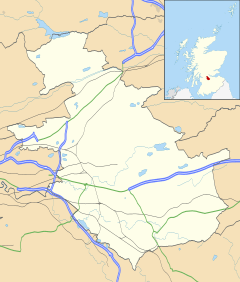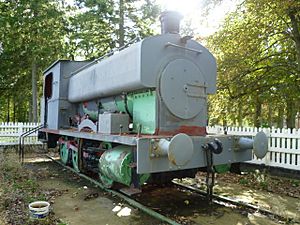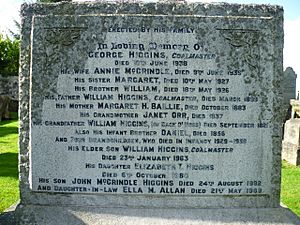Harthill, Scotland facts for kids
Quick facts for kids Harthill |
|
|---|---|
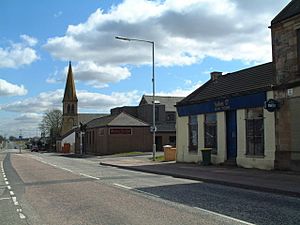 Main Street and church in centre of Harthill village, looking east |
|
| Population | 2,610 (2020) |
| OS grid reference | NS906643 |
| Civil parish | |
| Council area | |
| Lieutenancy area | |
| Country | Scotland |
| Sovereign state | United Kingdom |
| Post town | SHOTTS |
| Postcode district | ML7 |
| Dialling code | 01501 |
| Police | Strathclyde |
| Fire | Strathclyde |
| Ambulance | Scottish |
| EU Parliament | Scotland |
| UK Parliament |
|
| Scottish Parliament |
|
Harthill is a small village in Scotland. It is split between North Lanarkshire and West Lothian. Most of the village is in North Lanarkshire.
Harthill is located about 21 miles (34 km) west of Glasgow. It is also about 25 miles (40 km) east of Edinburgh. The village sits near the River Almond. It is about 2.5 miles (4 km) west of Whitburn.
Nearby major towns include Bathgate, 6 miles (10 km) away. Livingston is 10 miles (16 km) away. Other towns like Wishaw and Airdrie are 10 to 15 miles (16 to 24 km) west. The M8 motorway goes around the village. Harthill also has a service station named after it.
Contents
About Harthill Village
Harthill grew because of the coal mining industry. Many old miners' homes still stand today. The village was once part of Linlithgowshire. Later, it was divided between West Lothian and Lanarkshire.
The village of Greenrigg is next to Harthill on its east side. It is located in West Lothian. Some miners' homes are also found in Greenrigg. These include houses on Polkemmet Road and Stanley Road. The people living there worked in nearby coal mines.
The Polkemmet deep coal mine closed in 1984. This happened during a miners' strike. A mistake by pickets stopped firemen from keeping the pumps working. This caused the pit to flood and it could not be reopened.
Today, only a few buildings remain from the Polkemmet colliery. A steam engine, called a Pug, is now on display. It used to pull coal wagons. You can see it at the local Polkemmet Country Park. This park was once the private land of the Baillie family.
Many other mines were in the area, like the Benhar pit. Harthill, Eastfield, and Greenrigg now feel like one large village. However, each area still has its own strong identity.
Harthill is on the A8 and M8 roads. These roads connect Edinburgh and Glasgow. The M8 motorway bypassed the village in 1965. Scotland's first motorway service station opened here in 1971. It was originally called Harthill Services.
The service station was rebuilt around 2006. It was renamed Heart of Scotland services. A new, modern footbridge over the motorway opened in 2008. It cost £5 million. The service station is still owned by Transport Scotland.
The number 900 bus connects Harthill with Edinburgh and Glasgow. Buses run every 15 minutes from the service station. You can also park your car or bike there. Local bus routes also end here.
Local businesses include food distribution and making plastics. Harthill is also known for a change in accents. The accent spoken in Lanarkshire changes to the East Central Scots accent here.
Village History
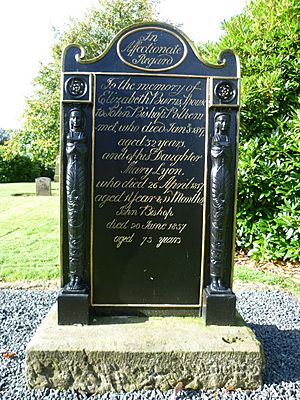
In 1767, the 'Turnpike' road system started in Scotland. The main road between Edinburgh and Glasgow passed through Harthill. By 1780, stagecoaches traveled through Harthill up to 20 times a day.
The 'Halfway House' was a place where horses could be changed. Travelers could also get food and drinks there. Elizabeth Burns, the daughter of Robert Burns, lived here. Her husband worked on the Polkemmet Estate. There is a memorial to her in the nearby Whitburn churchyard.
An early map from 1773 called Harthill 'Sidehead'. By 1795, it was known as 'Sideheads'. This name came from a building close to where Viewfield house now stands. Most people in the area were farmers at this time.
In 1616, there is a record of coal mining by John Muirhead. He had a coal pit near Kipp. This shows that coal mining was happening early on.
In 1685, King James VII allowed weekly markets and two annual 'fairs' at Kirk o'Shotts. These markets were mainly for buying and selling horses and cattle. By 1882, Harthill was a busy village. It had many business links and its own bank.
The Importance of Coal
Harthill and much of Central Scotland have a lot of coal. Digging for coal helped the area grow. The first coal pits in the area were at Benhar. Nine men worked there and earned 13 shillings a week.
These miners lived in homes provided by the pit owner. If they got sick or had an accident, they lost their home. Working conditions were very bad and dangerous.
In 1806, Lord Polkemmet opened a pit at Greenrigg. It employed 13 miners and two boys. This pit produced 8,000 tons of coal each year. The coal was sold in Edinburgh.
As the Industrial Revolution grew, demand for coal increased. More pits were opened across Scotland. More people started working in coal pits and factories than in farming.
In 1830, women and children as young as five pulled coal trucks to the surface. No accident records were kept. The Mines and Collieries Act 1842 banned women and children under ten from working underground. They were called 'coal-putters'. After this, women still worked above ground. They would sort coal and remove unwanted bits. It took another 30 years for children to get an education before working.
In 1887, a coal miner earned 4 shillings a day. A loaf of bread cost about a penny.
Greenrigg Colliery was taken over by United Collieries in 1905. It produced coal and clay. A fire in 1924 destroyed most of its buildings. The pit was rebuilt and worked until 1960.
On January 1, 1947, the National Coal Board took over all local pits. Many pits needed to be modernized. By the 1960s, smaller pits closed as larger, more productive ones were built.
Coal Pits Near Harthill
| Name of Pit | Men Employed Underground | Men Employed Above Ground |
|---|---|---|
| East Benhar | 64 | 21 |
| Greenrigg | 346 | 117 |
| Netherton | 83 | 18 |
| Blairmucklehill | 249 | 100 |
| Benhar | 620 | 143 |
| Hassockrigg | 263 | 68 |
| Fortissat | 221 | 41 |
| Hillhouserigg | 211 | 33 |
| Batton | 239 | 65 |
The Baillie Family and Their Impact
The Baillie family, also known as Lord Polkemmet, owned much land around Harthill and Whitburn. They bought the land in 1620. The Baillies built a large house, a mansion, in what is now Polkemmet Country Park. It was their family home for over 300 years.
The Baillies owned many local coal mines. Lord Polkemmet's son, William, became a baronet in 1823. Sir William Baillie and his wife extended the house in 1822. The family owned the building until the 1950s.
The mansion had 39 rooms and offices. It also had 11 servants. The grounds included stables, a mill, and tennis courts. The Baillie family helped the community a lot. They gave money for public buildings. These included the Baillie Institutes, which were community centers. The Baillie Institute in Harthill is now a Pentecostal church.
Sir William and Lady Baillie also started the Lady Baillie Sabbath School in Whitburn. Once a year, they opened their mansion to the public. They also made it available for Sunday school trips.
One famous member of the family was Sir Adrian. He was a Member of Parliament (MP) from 1931 to 1935. He married Cecilia Wilson-Filmer. She was very wealthy. Sir Adrian spent more time in London and Leeds Castle. The Baillie family stopped living at Polkemmet around this time.
During World War II, Polkemmet House was used as a war hospital. It also housed Polish soldiers who had fled Nazi-occupied Poland. These soldiers continued fighting from Britain.
In 1945, Polkemmet House became the 'Trefoil School'. This school was for handicapped children. Princess Elizabeth (who later became Queen Elizabeth II) officially opened it. She later became the school's patron. The Trefoil School moved in 1951. After that, the building became a police training school. It was later torn down.
Sir Adrian Baillie died in 1947. He was buried in the mausoleum on the estate. The mausoleum is the only part of the estate the family still owns.
Religion in Harthill
Before 1871, Harthill and Eastfield had no church building. Services were held in school buildings. Sir William Baillie helped fund a new church. One condition was that the school could be used for Sunday services.
Harthill and Eastfield were part of the Kirk o'Shotts parish. Before 1560, Kirk o'Shotts was a Catholic church. It was called St. Catherine's Chapel. After the Protestant Reformation, it became 'Shotts Kirk'. The current building opened in 1821.
The spire of this church was hit by lightning in 1876. There are still walls from the old cemetery watch-house. This building was used by families to guard graves. They watched for body snatchers who stole bodies for medical study.
The 1841 census showed Harthill had 289 people. By 1864, many people from Ulster moved to the area. They brought their interest in Orangeism. The first meeting of the Orange Lodge in Harthill was in 1874.
After Scotland and England united in 1603, King Charles I tried to control the Scottish Kirk. He wanted to force Episcopal religion on Scotland. Many Scots Presbyterians did not accept this. Thousands fought for their Presbyterian faith. They signed a 'Covenant' to keep their traditions. Following the King's prayer book became illegal.
Local Churches
The Harthill Free Church opened on July 20, 1871. The Harthill and Benhar Parish Church opened in April 1877. It cost £2,400 and could seat 660 people.
In 1879, Roman Catholics in Harthill began holding Mass in the Harthill Public School. A chapel was later built just outside the village.
In 2016, the churches in Harthill included:
- Benhar Evangelical Church
- St Andrew's Church of Scotland
- The Harvest Centre (Harthill Pentecostal Community Church)
- The Gospel Hall
- St Catherine's RC Church
Nearby Towns and Villages
Towns
Schools in Harthill
Early Schools (1820s – 1870s)
James Wilson's Endowed School was a single room. It was on the site of the Main Street School. James Wilson was a merchant who provided money for the school. He paid £25 a year for a teacher.
Eastfield School, also known as Benhar Works School, had its main buildings torn down. Sir William Baillie helped fund this school. He required that the school be used for Sunday Church services. The old school kitchen building is now used by the Eastfield & Harthill Flute Orchestra. It is called Benhar Hall.
Later Schools (1870s – 1998)
Harthill Public School replaced the James Wilson school. It was built by the Shotts School Board. By 1872, the Scottish Education Act required all children aged five to twelve to go to school.
Students who did not pass the Eleven plus exam continued at Harthill Junior School. From the 1970s, it became Harthill Primary School. All students then went on to secondary education. Students originally went to schools in Coatbridge or Airdrie. From the late 1970s, students could attend Calderhead High in Shotts.
Modern Schools (1999 – Present)
Harthill Primary School was the last school building on the original site. The two-story building was torn down in 1999. This happened after Alexander Peden Primary School opened. The old site is now empty.
Greenrigg Primary School replaced an older stone school that was destroyed by fire.
Alexander Peden Primary School opened in 1999. It replaced Harthill Primary and Benhar Primary. Both old schools were not fit for use. North Lanarkshire Council built the new school for over £4 million. It was their first new school.
The new school has modern features. These include a dining room and a gym hall with a stage. It also has a media room and high-tech security. The school can hold 300 primary children and 60 nursery children. The nursery has its own play area.
The school was supposed to open in 1997 but was delayed until 1999. Miss Morag Hay was the first Head Teacher. Mrs Tina Milligan was the first Deputy Head.
Polkemmet Country Park
The Polkemmet House estate was bought by West Lothian District Council in 1978. It was turned into a country park. The park opened in 1981.
Gala Day Fun
Harthill's Gala Day has been a tradition for over 100 years. It includes the nearby villages of Eastfield and Greenrigg. It is a day of fun that starts with a colorful parade. The parade includes floats, bands, and people in costumes. It marches from Alexander Peden Primary School through all three villages. It ends at Harthill Public Park.
The Crowning Ceremony in the park finishes the parade. Then, the Queen starts the sports and fun activities. In recent years, there have been paragliding shows and fireworks. A traveling fair, known as 'the shows', is also popular during Gala week. The Harthill, Eastfield and Greenrigg Children's Gala Day is held every year. It takes place on the second Saturday in June.
Greenrigg only had its own Gala day once. This was in 1947 and was held at the Polkemmet estate.
Sports in Harthill
Harthill is home to the Scottish Junior Football Association (SJFA) club Harthill Royal F.C.. This team plays in the East of Scotland Junior Football leagues. Even though Harthill is in North Lanarkshire, their park and clubhouse are in Greenrigg, West Lothian. The facilities include a floodlit training pitch and a clubhouse.
The village also had a senior football club for a short time, East Lanarkshire F.C.. They played in the Scottish Cup in the late 1800s. Another club, West Benhar F.C., also played here. They won the Lanarkshire Cup in 1882–83.
An annual golf competition is held between golfers from the West and East Coasts of Scotland. It is called the Harthill Trophy.
Famous People from Harthill
- Elizabeth Burns (1784—1817), the daughter of poet Robert Burns. She lived at the 'half way house' on the Polkemmet estate. She is buried in Whitburn Parish Church graveyard.
- Alex Cunningham, a Labour Member of Parliament (MP).
- Jimmy Drinnan (1906—1936), a footballer.
- Hugh McQueen (1867—1944), a footballer for Liverpool. He was the brother of Matt McQueen.
- Matt McQueen (1863—1944), a footballer who became a director and manager of Liverpool F.C. He was the brother of Hugh.
- John Moore (1943), a former footballer for Luton Town.
- William E. Somerville (1869—1950), an aircraft engineer.
- Eric Stevenson (1942–2017), a footballer with Hibernian.
- Graham Weir (1984), a football player. He is the brother of Steven Weir.
- Steven Weir (1988), a football striker. He is the brother of Graham Weir.
- Colin Cloud (1987), a stage mentalist. He appeared on America's Got Talent.
Population Growth
| Year | Population |
|---|---|
| 1861 | 216 |
| 1871 | 686 |
| 1881 | 1441 |
| 1891 | 1008 |
| 2001 | 3575 |
Images for kids
See also
 In Spanish: Harthill (Escocia) para niños
In Spanish: Harthill (Escocia) para niños


